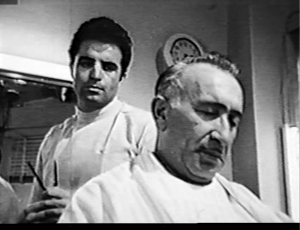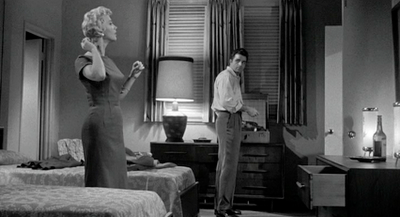
Although it’s belatedly become available on Columbia Pictures Film Noir Classics, Vol. 1 (along with two other particular favorites, The Big Heat and 5 Against the House), Murder by Contract (1958) doesn’t quite qualify as an undiscovered gem. But it’s certainly neglected in terms of some of its singular virtues, including a sharp Zen-like wit and a minimalist style. And what tends to be most neglected is its satirical treatment of business as murder. This is a theme it shares with Monsieur Verdoux — which makes it all the more fitting that a climactic sequence of the film was shot in Chaplin’s old studio lot, on what remains of an exterior set used for The Great Dictator.


At least two of the main creative talents working on this black comedy about capitalism, director Irving Lerner and uncredited screenwriter Ben Maddow, were blacklisted leftists, and the terse portrayal of a hitman (Vince Edwards, the star) as an independent contractor working hard to buy a house on the Ohio River to share with his unseen girlfriend — a sort of Haliburton or Blackwater operative avant la lettre, hired by an equally unseen Cheney, and calmly regarding his work like a self-improving Zen master — is at times downright hilarious. Read more
From the Winter 2019 issue of Cinema Scope. — J.R.
Since I don’t have much investment in parsing Arnaud Desplechin’s arsenal of “personal” references, I had to look elsewhere for the intermittent pleasures of Ismaël’s Ghosts (2017), available on a two-disc Blu-ray from Arrow Films. I often find myself so hard put to navigate Desplechin’s multiple allusions to and borrowings from Philip Roth and Woody Allen (for me, the most overrated and least interesting members of his overstuffed pantheon), much less those from James Joyce, Alfred Hitchcock, Norman Mailer, and Alain Resnais, that I have to forsake any sustained effort to rationalize how these and countless other figures could all belong to the same curious tribe of role models. Maybe this is because Desplechin appears to regard these touchstones as sacred talismans more than as meaningful or helpful artistic influences. Apart from naming László Szabó and Louis Garrel’s characters “Bloom” and “Dedalus,” respectively, it’s difficult to determine how much he’s actually learned or adapted from Ulysses—and when he combines nods to both Ulysses and Vertigo (1958) in the name of Marion Cotillard’s character “Carlotta Bloom,” the whole thing begins to seem like the silliest kind of fool’s game. As for Ismaël himself (Mathieu Amalric), is his name supposed to start us thinking about Moby-Dick, the Bible, or maybe both? Read more
This article was commissioned by the Torino Film Festival to accompany a John Cassavetes retrospective in November 2007, and was published there in a substantial catalogue/collection in Italian translation. I’m sorry I can’t do a better job of illustrating this: apart from some pictures of Cassavetes, Rowlands, and Carol Kane, there are no appropriate images available to me. I’m grateful, in any case, to Jim Healy and Emanuela Martini for asking me to write this. — J.R.
——————————————————-

Cassavetes’ Prelude and Postscript: The Original Shadows and A Woman of Mystery
by Jonathan Rosenbaum
——————————————————-
I consider myself unusually fortunate in having been able to see the original version of Shadows in January 2004. Shot in the spring of 1957 and screened publicly only four or five times, the first completed version of the first film of John Cassavetes had been considered irretrievably lost for almost half a century.
More specifically, I saw the first of two public projections at the Rotterdam International Film Festival of a good video transfer of the rediscovered 16-millimeter print, presented by Ray Carney, the man who rediscovered the print. After these two screenings, objections were raised by Cassavetes’ widow, Gena Rowlands, with the result that subsequent public screenings have been forbidden by her. Read more




